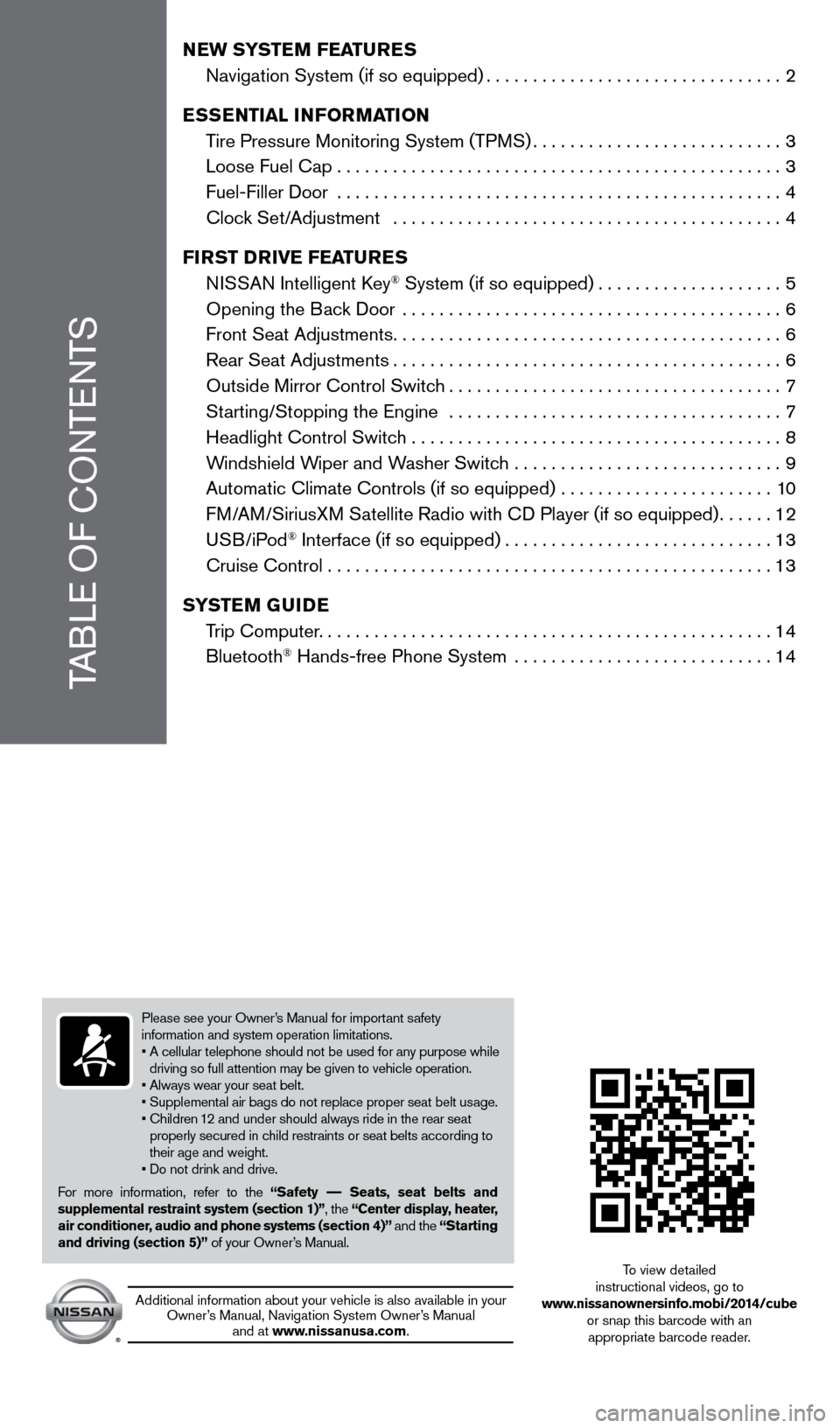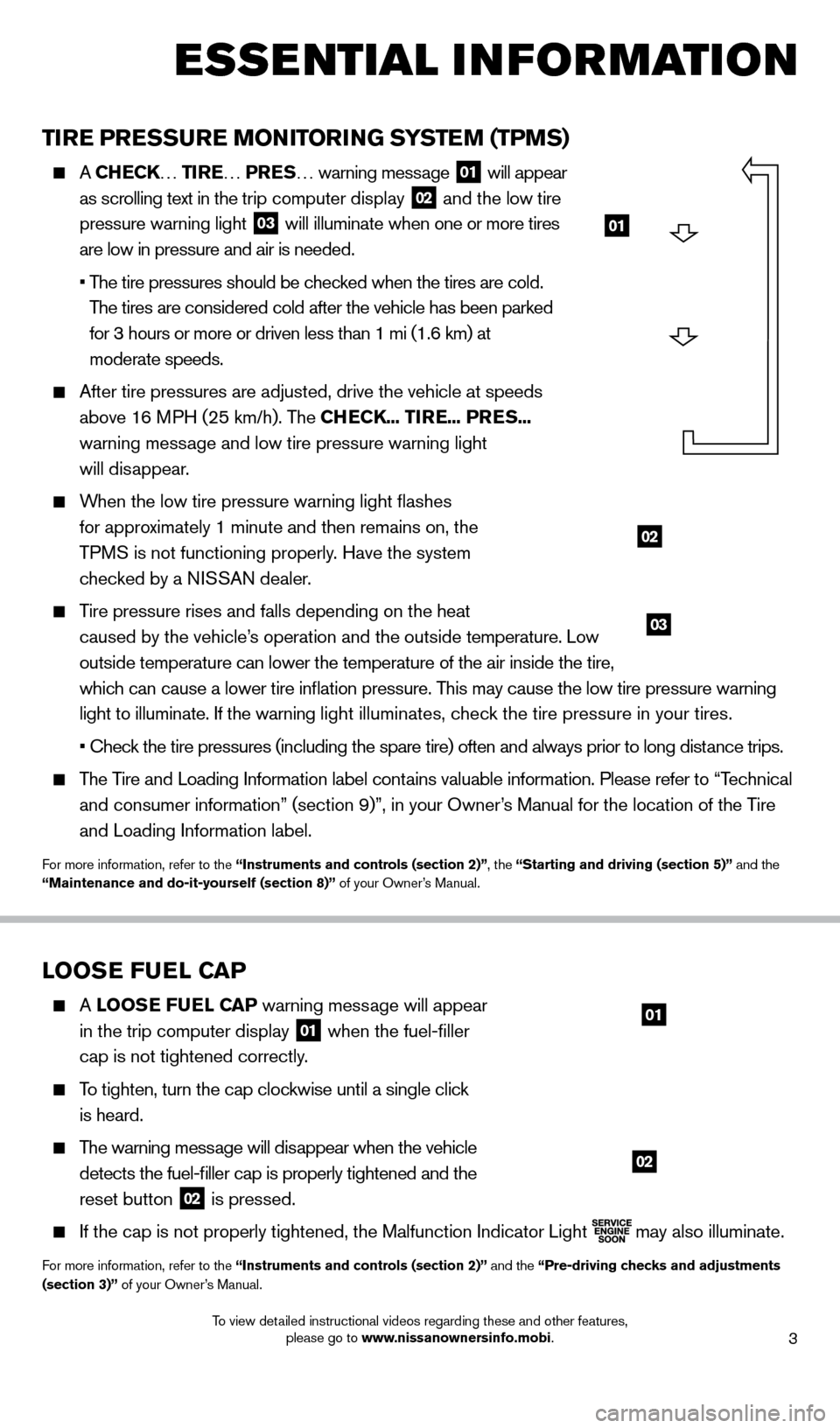TPMS NISSAN CUBE 2014 3.G Quick Reference Guide
[x] Cancel search | Manufacturer: NISSAN, Model Year: 2014, Model line: CUBE, Model: NISSAN CUBE 2014 3.GPages: 20, PDF Size: 1.16 MB
Page 3 of 20

TABLE OF
c
O
NTENTS
NEW SYSTEM FEATURES
Navigation System (if so equipped)................................2
E
SSENTIAL INFORMATION
T
ire Pressure Monitoring System (TPMS)
...........................3
Loose Fuel
c ap
................................................3
Fuel-Filler Door
................................................
4
c lock Set/Adjustment ..........................................
4
FI
RST DRIVE FEATURES
N
ISSAN Intelligent k
ey® System (if so equipped)....................5
Opening the B
ack Door
.........................................
6
Front Seat Adjustments..........................................6
Rear Seat Adjustments..........................................6
Outside Mirror
c
ontrol Switch
....................................7
St
arting/Stopping the Engine ....................................
7
Headlight
c
ontrol Switch ........................................
8
W
indshield Wiper and Washer Switch .............................
9
Automatic
c
limate
c
ontrols (if so equipped) .......................
10
F
M/AM/SiriusXM Satellite Radio with c
D Player (if so equipped)......12
USB/iPod
® Interface (if so equipped).............................13
c
ruise
c
ontrol . . . . . . . . . . . . . . . . . . . . . . . . . . . . . . . . . . . .\
. . . . . . . . . . . . 13
SYSTEM GUIDE
T
rip
c
omputer.
................................................14
Bluetooth
® Hands-free Phone System ............................14
Please see your Owner’s Manual for important safety
information and system operation limitations.
•
A cellular telephone should not be used for any purpose while
driving so full attention may be given to vehicle operation.
• Always wear your seat belt.
• Supplemental air bags do not replace proper seat belt usage.
•
Children
12 and under should always ride in the rear seat
properly secured in child restraints or seat belts according to
their age and weight.
• Do not drink and drive.
For more information, refer to the “Safety –– Seats, seat belts and
supplemental restraint system (section 1)”, the “Center display, heater,
air conditioner, audio and phone systems (section 4)” and the “Starting
and driving (section 5)” of your Owner’s Manual.
Additional information about your vehicle is also available in your Owner’s Manual, Navigation System Owner’s Manual and at www.nissanusa.com.
To view detailed
instructional videos, go to
www.nissanownersinfo.mobi/2014/cube or snap this barcode with an appropriate barcode reader.
1523989_14_Cube_QRG_091613.indd 49/16/13 3:30 PM
Page 5 of 20

3
esse ntial i n for mation
TIRE PRESSURE MONITORING SYSTEM (TPMS)
A CHECK… TIRE… PRES … warning message 01 will appear
as scrolling text in the trip computer display 02 and the low tire
pressure warning light 03 will illuminate when one or more tires
are low in pressure and air is needed.
•
T
he tire pressures should be checked when the tires are cold.
The tires are considered cold after the vehicle has been parked
for 3 hours or more or driven less than 1 mi (1.6 km) at
moderate speeds.
After tire pressures are adjusted, drive the vehicle at speeds
above 16 MPH (25 km/h). The CHECK... TIRE... PRES...
warning message and low tire pressure warning light
will disappear.
When the low tire pressure warning light flashes
for approximately 1 minute and then remains on, the
TPMS is not functioning properly. Have the system
checked by a NISSAN dealer.
Tire pressure rises and falls depending on the heat
caused by the vehicle’s operation and the outside temperature. Low
outside temperature can lower the temperature of the air inside the tire\
,
which can cause a lower tire inflation pressure. This may cause the low tire pressure warning
light to illuminate. If the warning light illuminates, check the tire pressure in your tires.
• Chec
k the tire pressures (including the spare tire) often and always prior to long distance trips.
The Tire and Loading Information label contains valuable information. Please refer to “Technical and consumer information” (section 9)”, in your Owner’s Manual for the location of the Tire
and Loading Information label.
For more information, refer to the “Instruments and controls (section 2)”, the “Starting and driving (section 5)” and the
“Maintenance and do-it-yourself (section 8)” of your Owner’s Manual.
01
02
03
LOOSE FUEL CAP
A LOOSE FUEL CAP warning message will appear
in the trip computer display
01 when the fuel-filler
cap is not tightened correctly.
To tighten, turn the cap clockwise until a single click
is heard.
The warning message will disappear when the vehicle
detects the fuel-filler cap is properly tightened and the
reset button
02 is pressed.
If the cap is not properly tightened, the Malfunction Indicator Light
may also illuminate.
For more information, refer to the “Instruments and controls (section 2)” and the “Pre-driving checks and adjustments
(section 3)” of your Owner’s Manual.
01
02
1523989_14_Cube_QRG_091613.indd 39/16/13 3:31 PM
To view detailed instructional videos regarding these and other features, please go to www.nissanownersinfo.mobi.